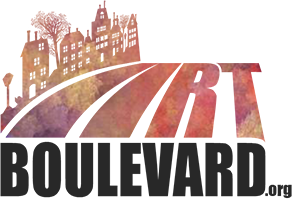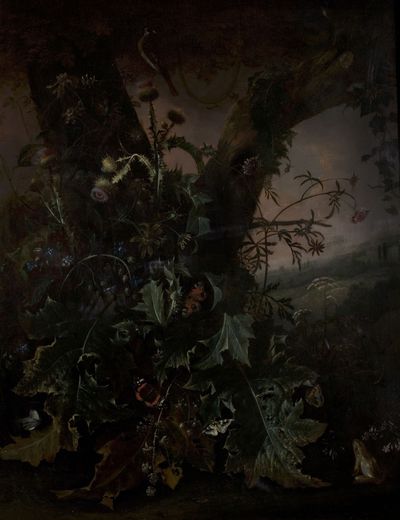Javascript must be enabled to continue!
painting (oil): ["Still Life with Frog and Goldfinch"] aka ["Thistles and Butterflies"]
View through Europeana Collections
"of "Thistles, Butterflies, etc - Landscape background"" [Register] An outdoor still life set at sunset and composed around an oak tree with, from left to right; borage, cotton thistle, rudbeckia, scabious, cow parsley, trumpet honeysuckle and ivy. Butterflies, including red admiral and peacock species, and moths can be seen feeding on the leaves of the plants. At the top of the composition, a goldfinch is perched on a thistle head. To the right, hanging from the tree is the loop of a bird snare. On the ground in the lower right corner, a frog looks upwards. In the background to the right is a landscape with cypress trees. In NCM 1904-105, traditional "Vanitas" elements are referenced through images of the natural cycle of life and death, such as in the depiction of caterpillars alongside the adult moths and butterflies that they will become. The frog is preparing to make a meal of the butterfly feeding on the bramble that flutters above and the goldfinch sits beside a snare that will trap and kill it. Virag 15/12/2004, Between 1984 and 1985, a research assistant, Dr. Brendan Cassidy, was employed by Nottingham Castle Museum to research and write a catalogue of the foreign oil paintings in their collection. The catalogue never materialised, but drafts and notes relating to Cassidy's research can be found in the Artist Files and in the Archive at the museum. All references to Cassidy relate to these documents. The early-evening setting underscores the overall message of death and decay. The interaction between the creatures included in 17th century Dutch still lifes have been read by some scholars as signifying a covert moral narrative that is played out in a struggle between good and evil in Nature. A date of "about 1669" has been suggested by Cassidy on the basis of a comparison with another signed and dated still life by Withoos, now in a Swiss private collection, and which is similar in treatment and choice of motifs. The painting was cleaned and the canvas re-lined in 1969 by W. Holder & Sons, London, when discoloured varnish and past repair work were removed. During this restoration, the frog at the lower right of the painting and the goldfinch at upper centre were discovered under foliage that had been added to the original painting at a later date, probably in the nineteenth century. Virag 15/12/2004, Collection of Richard Godson Millns
Title: painting (oil): ["Still Life with Frog and Goldfinch"] aka ["Thistles and Butterflies"]
Description:
"of "Thistles, Butterflies, etc - Landscape background"" [Register] An outdoor still life set at sunset and composed around an oak tree with, from left to right; borage, cotton thistle, rudbeckia, scabious, cow parsley, trumpet honeysuckle and ivy.
Butterflies, including red admiral and peacock species, and moths can be seen feeding on the leaves of the plants.
At the top of the composition, a goldfinch is perched on a thistle head.
To the right, hanging from the tree is the loop of a bird snare.
On the ground in the lower right corner, a frog looks upwards.
In the background to the right is a landscape with cypress trees.
In NCM 1904-105, traditional "Vanitas" elements are referenced through images of the natural cycle of life and death, such as in the depiction of caterpillars alongside the adult moths and butterflies that they will become.
The frog is preparing to make a meal of the butterfly feeding on the bramble that flutters above and the goldfinch sits beside a snare that will trap and kill it.
Virag 15/12/2004, Between 1984 and 1985, a research assistant, Dr.
Brendan Cassidy, was employed by Nottingham Castle Museum to research and write a catalogue of the foreign oil paintings in their collection.
The catalogue never materialised, but drafts and notes relating to Cassidy's research can be found in the Artist Files and in the Archive at the museum.
All references to Cassidy relate to these documents.
The early-evening setting underscores the overall message of death and decay.
The interaction between the creatures included in 17th century Dutch still lifes have been read by some scholars as signifying a covert moral narrative that is played out in a struggle between good and evil in Nature.
A date of "about 1669" has been suggested by Cassidy on the basis of a comparison with another signed and dated still life by Withoos, now in a Swiss private collection, and which is similar in treatment and choice of motifs.
The painting was cleaned and the canvas re-lined in 1969 by W.
Holder & Sons, London, when discoloured varnish and past repair work were removed.
During this restoration, the frog at the lower right of the painting and the goldfinch at upper centre were discovered under foliage that had been added to the original painting at a later date, probably in the nineteenth century.
Virag 15/12/2004, Collection of Richard Godson Millns.
Related Results
painting, painting, painting, painting, painting, painting, painting, painting, painting, painting, painting, painting, painting, painting, painting, painting, painting, painting, painting, painting, painting, painting, painting, painting, painting, paint
painting, painting, painting, painting, painting, painting, painting, painting, painting, painting, painting, painting, painting, painting, painting, painting, painting, painting, painting, painting, painting, painting, painting, painting, painting, paint
"Here is portrayed three Moods of the Sky and the effects on the Fish and Animals. Sharks and Turtles come to the Surface when it is Raining. Wallabies and Kangaroos are out feedin...
painting (oil): ["Still Life with Dead Game"] aka ["Pigeon and Other Birds"]
painting (oil): ["Still Life with Dead Game"] aka ["Pigeon and Other Birds"]
At the left of this outdoor still life, some purple-headed thistles grow at the foot of a tree trunk. A number of dead birds, including some finches and a snipe, hand from a branch...
painting (oil): ["Peasants Fleeing"] aka ["Witchcraft"]
painting (oil): ["Peasants Fleeing"] aka ["Witchcraft"]
"May have been a section of a larger painting; subject relating to witchcraft. Unsigned." [Register] "It is painted in grisaille and appears, from the way the panel is cut, to be t...
painting (oil): ["Trees by a Brook"] aka ["The Willow Tree, a Horseman and a Woman on a Road"]
painting (oil): ["Trees by a Brook"] aka ["The Willow Tree, a Horseman and a Woman on a Road"]
A large (oak?) tree stands in the centre of the landscape, with a small plank fence built around it. There is another, thinner, (birch?) tree to the left, and in the foreground a s...
painting (oil): "After the lion hunt" aka "W.F. Webb, South Africa"
painting (oil): "After the lion hunt" aka "W.F. Webb, South Africa"
William Frederick Webb and Captain W. Codrington at the end of a lion hunt in South Africa with a young African bearer about to skin the kill watched by 3 dogs; beyond an African b...
painting (watercolour): ["A Cave with Man and Woman Bathing"] aka ["Naiades of the Deep"]
painting (watercolour): ["A Cave with Man and Woman Bathing"] aka ["Naiades of the Deep"]
NCM 1889-331, NCM 1890-242, NCM 1890-239, NCM 1890-241 mounted together. Seascape seen from inside a cave. A woman reaches out towards another figure who is being drawn into a larg...




